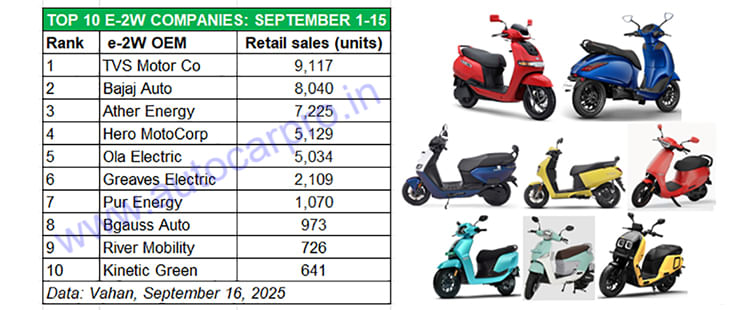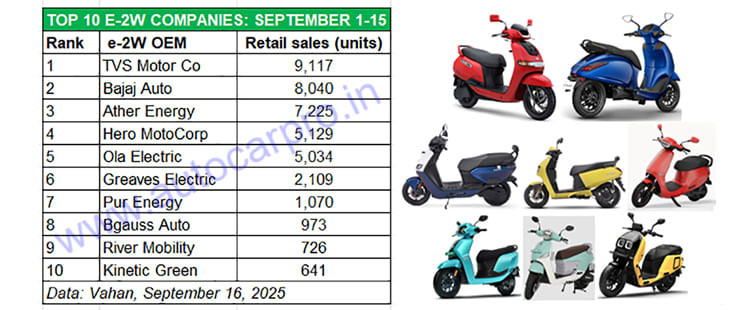The first half of September is over, and, as per Vahan retail sales statistics, the Indian electric two-wheeler industry has delivered a total of 42,278 units. This is around 10–15% less than in the first halves of the past four months. The tepid sales can be attributed to the ‘Shraddh’ period (September 7–21). Vehicle buying is expected to pick up with gusto after the 22nd, when the Navratri festival begins. Nevertheless, for the September 1–15 period, TVS Motor Co has maintained its No. 1 status, which it first achieved in April 2025.
The top five OEMs — TVS Motor, Bajaj Auto, Ather Energy, Hero MotoCorp, and Ola Electric — have each sold over 5,000 units and are the movers and shakers of this segment. The next five, led by Greaves Electric Mobility, are also witnessing strong demand and, as a result, regularly feature in the Top 10 list. In the first half of September, these Top 10 OEMs, with 40,064 units, account for 95% of the 42,278 e-2Ws delivered to consumers.
 TVS leads the 200-strong e-2W industry with sales of 9,117 units in the first half of September 2025.
TVS leads the 200-strong e-2W industry with sales of 9,117 units in the first half of September 2025.
TVS Motor Co continues to hold sway over the 200-plus e-2W players in the segment, with 9,117 units and a 22% share in the first half of September. The company, whose main growth driver till now has been the iQube, has recently launched the Orbiter e-scooter at ₹99,900 (ex-showroom Bengaluru), inclusive of PM E-Drive Scheme subsidies. This prices the Orbiter — which has a 3.1 kWh battery pack — on par with the base iQube variant that features a smaller 2.2 kWh battery pack. The Orbiter, which has a top speed of 68 kph, is designed for urban commuting and has an IDC range of 158 km per charge. Deliveries of TVS’ newest EV are slated to begin at the end of this month and should further boost TVS’ monthly numbers.
The big news of the past fortnight is that Bajaj Auto, which had faced production hurdles in July and the first half of August due to constraints caused by global rare earth magnet (REM) availability, is back in the ‘game’. The Pune-based company has reclaimed its No. 2 spot after having been relegated to fifth rank in July. Between September 1–15, Bajaj has delivered 8,040 Chetaks — that’s 1,077 units behind the TVS iQube. In view of the ongoing festive season, the company has begun scaling up production. Bajaj Auto, which resumed full production on August 21 with REM supplies back on stream, is working on two solutions: using light rare earth magnets, which are more easily available, and also developing new magnet technologies that negate the use of rare earth materials.
A strong third-ranker in the Top 10 is Ather Energy, with 7,225 units in the first half of September. Its flagship Rizta family e-scooter, which surpassed 100,000 wholesale units 13 months after its launch in April, remains Ather’s key growth driver and currently contributes over 60% of its sales each month. This is creditable, given that the three-variant flagship scooter is a premium product.
Hero MotoCorp, the world’s largest two-wheeler manufacturer, continues to be in the news with robust demand for its new Vida VX2 model. With 5,129 units, the company bids fair to cross the 10,000-unit sales mark for the third month in a row after August (13,313 units) and July (10,537 units), and is 95 units ahead of Ola Electric.
Ola Electric is ranked fifth in the Top 10 e-2W table, with 5,034 units. The bulk of Ola’s sales come from the 14-variant S1 e-scooter, which straddles multiple price points — from entry-level mass mobility through to premium. The S1 Pro, equipped with a 4 kWh battery, has a claimed 142 km range on a single charge and has an ex-showroom price of ₹154,999. Ola also manufactures and sells the Roadster X electric motorcycle, which develops peak power of 11 kW, a top speed of 125 kph, and has a range of 501 km. On August 15, at its annual event, Ola Electric announced a clutch of new products, next-gen software, and announcements about future vehicles and technologies. It revealed the Ola S1 Pro Sport, which will be the most powerful Ola scooter, slated for debut in January 2026.
Greaves Electric Mobility (GEM), the EV arm of Greaves Cotton, which markets the Ampere brand of e-scooters, maintains its sixth rank with 2,109 units — this marks strong growth of 59% YoY and gives it a 4% market share. The company has three key e-scooter brands: Nexus (EX and ST), Magnus (Neo and EX), and Reo (80 and Li Plus). While the flagship Nexus remains the best-selling product for GEM and Ampere Vehicles, the company is seeing growing demand for the new Ampere Reo 80, launched in April at ₹59,900. GEM has recently launched the upgraded Nexus, whose highlight is ‘Map Mirroring’ technology, along with an enhanced connectivity platform called Nex.IO.
The upgraded Nexus features a 7-inch TFT display that provides full-screen navigation with zoom functionality, estimated time of arrival, and distance-to-next-turn information. The system also integrates dashboard monitoring, music control, call connectivity, and safety alerts.
Pur Energy, the Hyderabad-based EV startup incubated from the i-TIC at IIT Hyderabad, is now a regular entry in the monthly Top 10 e-2W OEM list. The company, which has a five-model portfolio, has clocked sales of 1,079 units to take the No. 7 position.
Bgauss Auto, a Mumbai-based startup spawned by electrical solutions major RR Kabel, is also witnessing strong demand for its two products, the RUV 350 and Max C12. In the first half of September, Bgauss delivered 973 units to take eighth rank.
Bengaluru-based e-2W startup River Mobility has sold 726 units of its single product — the River Indie.
Wrapping up the Top 10 e-2W OEM list is Kinetic Green, with 61 units. The company has three products — the e-Zulu, Zing, and the e-Luna moped. The company clocked retails of 1,513 units last month. The growth comes ahead of the planned launch of a new premium family scooter in CY2026, the first of three models to be launched over the next 18 months.
The last nine days of September, starting from the 22nd and coinciding with the Navratri festival, will usher in a new wave of demand for India EV Inc as well as the overall automotive industry. The rollout of GST 2.0 from the fourth week of this month is set to be a game-changer — lowering household expenses, lifting consumption, and improving industry competitiveness. According to dealer body FADA, economists expect it could reduce inflation by up to 1.1 percentage points. With GST 2.0 as a landmark reform, proactive OEM schemes, and the onset of India’s biggest festivals, FADA states that it is “decisively optimistic” that September will mark the beginning of a strong growth cycle for auto retail sales.
ALSO READ: Top six e-2W OEMs command 76% share of 3.65 million units sold since 2018
